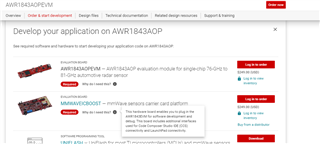Other Parts Discussed in Thread: AWR1843BOOST, , MMWAVEICBOOST, TMDSEMU110-U, AWR1843AOP
I wanted to debug my AWR1843AOPEVM board but in schematic as well as on board I couldn't find the emulator chip (XDS110) which was present on my AWR1843BOOST
But I could see a JTAG header on the board, can I use these pins to debug the board using the emulator present on my BOOST board if yes could you provide any reference document regarding how to do the same
or do I need to use the 60pin HD connector to debug my AOP board and get some external debugger like MMWAVEICBOOST to debug the board.
Also what is the procedure to debug using XDS110 Debug Probe
https://www.ti.com/tool/TMDSEMU110-U
Thanks



